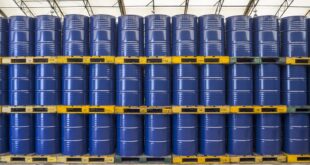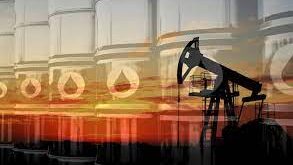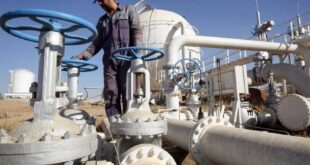Iran’s petroleum industry went through a tough and breathtaking period in the calendar year 1398 (ended March 19) as the United States tightened its sanctions on this sector. However, the developments of Iran’s last calendar year show that the country has managed to go ahead with its capacity building projects with a view to maximizing its output once the sanctions have been lifted. That is exactly what happened after Iran struck its historic 2015 nuclear deal with six world powers as the country immediately lifted its oil output capacity.
Spring, Calm Start but Newsworthy End
Well D-6 in the zone run by the Iran Offshore Oil Company (IOOC) and Well 140 in the Rag Sefid field became operational. The salty and sweet oil pumping system in Aghajari No. 2 production unit is upgraded.
The engineers in the Tang Bijar operating zone managed to launch a steam trace system.
Minister of Petroleum Bijan Zangeneh visited Moscow to discuss the fragile conditions of supply and demand in the oil market with his Russian counterpart. One week after the visit, Thamir Abbas Al Ghadhban Deputy Prime Minister for Energy Affairs and Iraq’s minister of oil travelled to Iran and visited EIED, a subsidiary of the Oil Industries Engineering and Construction Company (OIEC). During the visit, Iran and Iraq were said to have reached agreement on developing the Naftshhahr and Khorramshahr fields, jointly owned by the two countries.
National Iranian South Oil Company (NISOC) announced that for the first time a rotor of Clark gas compressor operated by this company had been repaired by the company’s engineers. Furthermore, a Rolls-Royce turbine and its compressors would be overhauled and come online after years of non-operation at the Aghajari gas and liquefied gas plant.
Operations to build a tower to separate propane from sweetened gas – as one of major equipment in the Kharg LNG project – ended in Ahvaz. Offshore cable-laying operations in the wellhead platforms 7 and 8 of Bahregansar platform (electric cable and fire optics) ended in less than two months.
One of oil tankers operated by National Iranian Tanker Company (NITC) was stopped in the Red Sea after water penetrated into its engine chamber. However, the oil tanker was put in stable conditions and all 26 crewmembers were announced to be in full health.
US sanctions waivers to the eight major buyers of Iran’s crude oil came to an end. At the same time, Minister Zangeneh met with Mohammad Sanusi Barkindo the visiting OPEC Secretary General on the sidelines of the Tehran Oil Show.
During the exhibition, NISOC signed agreements with domestic consulting companies to conduct studies on six reservoirs. Furthermore, five technological achievements of the Research Institute of Petroleum Industry (RIPI) were unveiled.
Relying on its own knowhow and expertise, RIPI is operating as the most specialized technological body involved in the petroleum industry. The overhaul of gas production installations at the Khangiran field, as well as the installations in the Nar, Kangan, Aghar and Dalan areas started. Meantime, 14 exploration blocks and their financing model were introduced to Iranian E&P companies.
Operations for the safety of main and auxiliary oil and gas pipelines in Maroun were over and the protection and fire alarm system on the Belal platform wells were installed and launched while nothing was outsourced. The annual overhaul of the two platforms of Phases 4 and 5 of the South Pars gas field, as well as the platforms of SP10 and SP16 were successfully ended in the mechanical, electrical, instrumentation, inspection, health, safety and environment sectors.
Explosions were reported on oil tankers in Fujaira Port in the United Arab Emirates, while Yemeni drones struck two oil pumping stations in Saudi Arabia.
In the South Zagros area, two oil development wells came online in the Sarvestan and Sadatabad areas. A homegrown riser was installed in the Kharg waters to serve the drilling industry for the first time.
Minister Zangeneh issues a directive, setting priorities for the four subsidiaries of Petroleum Ministry – National Iranian Oil Company (NIOC), National Iranian Gas Company (NIGC), National Petrochemical Company (NPC) and National Iranian Oil Refining and Distribution Company (NIORDC) – as well as the Office of Deputy Minister for Engineering, Research and Technology. The priorities include completing the production capacity and startup of SP13, SP14 and SP22-24, enhancing crude oil production capacity in West Karoun’s joint oil fields, building the Goureh-Jask pipeline and a crude oil export terminal in Jask Port.
The Khangiran gas gathering center as the largest gas gathering center in Iran came online in Sarakhs, while two projects became operational in the West Karoun power plant. NISOC developed a smoke-free flare; a 940-tonne top drive is installed on Platform 18F of the Forouzan oil field. This platform has been designed and built in Iran.
Enhancing the gas recovery capacity and the sustainable production period in SP4 using perforation operations in the K reservoir layer, perforation of the K1 layer (in 11 wells) and acid job (in 9 wells) were carried out. Platform 14B was loaded out from the Iran Shipbuilding & Offshore Industries Complex Co (ISOICO) yard in Bandar Abbas.
Summer, Oil Installations and Tankers
Apart from the seizure of an Iranian oil tanker in Gibraltar and the seize of Britain’s Stena Impero tanker by Iranian navy forces, OPEC+ countries (OPEC and non-OPEC allies) agreed to extend their previous agreement for a 1.2 mb/d cut from their output up to March 2020.
For the first time in Iran’s shipbuilding industry, ISOICO managed to overhaul an Iranian very large crude carrier.
Installation of a 500-tonne structure of Platform FY-B in the Forouzan field, repairing VGVC in the SGT turbine, composing for the first time in Iran by NISOC, using internal coating technology in coiled tubing and casings for the first time in the Masjed Soleiman oil field development project, overhaul of two oil mobile transporter (MOT) and one mobile oil separator (MOS) units for the first time by engineers at the Karoun Oil and Gas Production Company, designing defective parts of a solar turbine by the Aghajari Oil and Gas Production Company engineers were among developments at the start of this season.
The third platform of SP14 was installed. The Exploration Directorate of NIOC announced that it had started in partnership with an Iranian-European consortium gravimetric and magnetometric data gathering in the Kopet Dag area in Khorasan Razavi Province.
The Parsi field gas gathering project received the Energy Globe Foundation award while NISOC announced that the UPS system of the gas injection station of the Aghajari Oil and Gas Production Company, as well as the subsurface valves of Well No. 313 of the Masjed Soleiman field had been repaired domestically.
As far as environmental projects are concerned, the South Zagros Oil and Gas Production Company brought the 44-kw Sarvestan and Saadatabad photovoltaic power plant on-stream, while five troughs were prepared for wildlife living in the Parsian area. Meantime, more than 500 items of commodities required by the petroleum industry were built or repaired during the first four months of the calendar year. The West Oil and Gas Production Company said that in addition to repairing the Nafthshahr desalination reboiler, part of the Cheshmeh Khosh pipeline was renovated. The company’s engineers have developed a system to test automatic safety valves.
Once a downhole pump is installed in Well No. 4 of the North Yaran field, over 1,000 b/d would be added to the field’s output. In South Pars, in addition to commencement of storage at four propane and butane tanks for the refinery of SP19, the platform of SP23 and the flare support of Platform 13A were loaded at SADRA yard. The riser of oil pipeline in Platform R4 of the Reshadat field was replaced and the solar turbines detection system in Salman field platform was renovated. A new 100,000-tonne single-point mooring was installed in the area run by the Fajr Jam gas refining company in order to enhance the loading capacity of gas condensate.
Well No. 30 of the Aghajari field became operational and the Aghajari Oil and Gas Production Company announced that 1,563 items used in processing equipment had been built.
In the last month of summer, as planned previously, the overhaul of many installations run by the Iran Central Oil Fields Company (ICOFC) was over.
The South Zagros Oil and Gas Production Company started operating its fire and gas detection system.
In South Pars, the main power supply post of the onshore refinery of SP14 was launched, while Pars Oil and Gas Company (POGC) signed an agreement with Petropars for developing Belal gas field.
At the Iran Oil Terminals Company (IOTC), Iranian engineers managed to overhaul and launch Haft-e Tir tugboat.
A project for reinforcing the berthing structure of Platform PLQ of the Belal field, reducing the weight of the Norouz 1 oil platform in Bahregan, four reparation, reconstruction and renovation projects in the Siri area were launched aimed at production sustainability. The top drives of platforms 7 and 8 of the Hendijan field, weighing 1,000 tonnes each, were loaded from the ISOICO factory in Bandar Abbas.
At the end of summer, major installations of Saudi oil giant Aramco were attacked, which were the most severe event since the Persian Gulf War. The attacks on Aramco’s facilities that halved Saudi oil output sharply pushed up crude prices.
Autumn, Oil Deals and Discovery
The first offshore coupling connected to single-point mooring at IOTC was repaired while the first rotary actuator needed in oil and gas industry valves was built by the Pars Special Economic Energy Zone. The first hydraulic pump was developed by Iranian drilling experts.
Development of the giant South Azadegan oil field was officially awarded to the Arvandan Oil and Gas Production Company. In South Pars, the main Platform 23 and the satellite Platform 24B were headed to the Persian Gulf for installation in their predetermined location.
Minister Zangeneh visited Moscow to attend the 21st ministerial meeting of Gas Exporting Countries Forum (GECF).
He announced in the first month of autumn that Petropars would go it alone in developing SP11 following the pull out of France’s Total and China’s CNPCI.
The agreements for making 50 pumps needed in the Goureh-Jask oil pipeline, worth about € 48 million, were signed between the Petroleum Engineering and Development Company (PEDEC) and Pumpiran and Petco.
The NIOC Exploration Directorate signed two seismic testing agreements with two Iranian companies. One was with the Oil Exploration Operations Company for implementing 2D seismic testing and the other one with Tenco for 3D seismic testing.
National Iranian Oil Company (NIOC) announced a new gas find in the southern Fars Province. The Eram field with 19 tcf (540 bcm) of gas reserves in place, 13 tcf of which would be recoverable.
An Iranian oil tanker was struck with a rocket just 60 miles from Jeddah Port. It was towed into Iranian territorial waters after ten days.
Minister Zangeneh announced the discovery of a new oil reservoir, i.e. Namavaran. Exploration operations had started in 2016 by applying the most advanced methods and drilling three wells. That added 22 billion barrels to the country’s oil reserves in place and 2.2 billion barrels to recoverable oil.
The first and deepest ever directional well was drilled in Kajdomi Formation of the South Azadegan oil field. Platform of SP23 and Platform 24B were installed. Gas production from the Sarajeh and Shourije underground storage sites started. PLC systems were installed on Well No. 44 of Khangiran, while smart pigging was concluded there.
The 177th meeting of the Organization of the Petroleum Exporting Countries and their allies was held on oil output cut. They agreed to cut another 503,000 b/d from their total output.
An extraordinary ministerial meeting of GECF member states was held in Equatorial Guinea.
Other developments in the final month of autumn included the reparation of machinery and some parts of mud pumps on the location of Fath 33 rig to prevent any halt in operations, successful driving of the completion string of the first development well in the drilling of 40 wells in South Azadegan and providing auxiliary services and installing air hose, rebuilding and re-launching the turbopump of production unit number 3 in the Aghajari Oil and Gas Production Company, launching an environmental project for gathering gas waste in the Karoun Oil and Gas Production Company, enhancing the output of the Khangiran area by 1 mcm/d, inaugurating a low-pressure gas gathering project, saving the country more than 700,000 dollars, conclusion of overhaul of 22 gas platforms in the South Pars gas field, installing the structures of platforms 23 and 24B, and increasing the condensate storage capacity of South Pars.
Winter, Corona Outbreak and Oil Crash
PEDEC announced that studies and screening by the Petroleum Engineering Institute of the University of Tehran on the Azadegan field have proven the capability for a 10% increase in the recovery rate of the oil field Iran shares with Iraq by applying enhanced oil recovery (EOR) methods.
NISOC announced that the studies jointly conducted by universities and research institutes on the six fields of Ahvaz, Karanj, Koupal, Mansouri, Gachsaran and Bibi Hakimieh had resulted in significant results.
The S1 wellhead platform of the Salman field, built domestically, was loaded out in Khorramshahr Yard and pipe-laying for gas projects in South Pars were over. Gas recovery from top drive 14B started. The last offshore platform of SP14 was loaded out in SADRA Yard and the third platform came online. The novel coronavirus outbreak hit international headlines.
The overhaul of the Hangam gas processing installations ended while the satellite 14D platform was installed. The last flare of the gas platform of SP22-24 was turned on and the 24B platform became ready for gas recovery and delivery to refinery.
The Khazar Exploration and Production Company (KEPCO) adopted a plan for testing wells in the Sardar-e-Jangal field to be presented to the NIOC Department of Incorporate Planning. In northeast of Iran, a new well with a production capacity of more than 1.3 mcm/d became operational in Khangiran.
An agreement was signed between NIOC and power utility MAPNA for increased production from Parsi and Paranj fields. Well No. 44 of the Parsi field came online by using for the first time the gas lifting technology.
The Fath 72 drilling rig, built by the Academic Center for Education, Culture and Research (ACECR) was unveiled by Minister Zangeneh in Ahvaz. It was the 6th rig built by Iranian manufacturers.
The agreement for a skied-mounted processing unit in the South Azadegan oil field was signed between PEDEC and ACECR under a build-operate-transfer (BOO) deal.
The 178th meeting of the OPEC Conference was held in Vienna without any agreement between OPEC and non-OPEC allies. Oil prices started a downward trend.
NIOC continues to follow up on various overhaul and reconstruction projects, including the overhaul of three gas injection compressors in the third train of oil installations in Darquain. IOTC also announced the development of an automatic sampling system in partnership with Iranian knowledge-based companies.
In Kharg, a 2.4km pipeline was inaugurated to carry fuel to the power plant there. In Lavan, the deoxygenation tower of steam boilers was installed and made operational while the input and output pipes of the desalination unit of the Salman oil processing plant were replaced.
The coronavirus was a gatecrasher from which Iran’s petroleum industry was not spared either. The Petroleum Ministry, NIOC and its subsidiaries adopted plans for countering the impacts of Covid-19. The Emergency Conditions Committee raised the alert level to 3.
In South Pars, Platform 13A and its structures were installed and the last platform of SP22-24 started gas production to be delivered to its onshore refinery. The wellhead platform S1 was installed in the Salman field and the first phase of gas sweetening in Asmari came online. On the final day of the year, the last platform in the SP14 development project came online.
Several days before the start of the new calendar year, Zangeneh banned any leave for operational managers in the petroleum industry companies as long as the coronavirus has not been contained, except for emergency purposes.
 Iran Energy News Oil, Gas, Petrochemical and Energy Field Specialized Channel
Iran Energy News Oil, Gas, Petrochemical and Energy Field Specialized Channel




